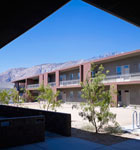SCENE
Palm Springs is famous for palm tree-lined streets, rugged mountain vistas, and 354 days of sunshine—all of which have helped make it an oasis for Hollywood legends and average citizens. Also attractive are the mild winters, but summertime is another matter. In July, the average daily high is 108 degrees Fahrenheit.
For this iconic but harsh setting, Brooks + Scarpa designed the Rosa Gardens affordable housing community for the Coachella Valley Housing Coalition. The 57-unit project sits on 4.5 acres of previously developed land on Rosa Parks Road (also called Las Vegas Road), the main entry to Palm Springs from the northwest.
“It’s next to the Visitors Center on the edge of town,” says Lawrence Scarpa, principal of the Los Angeles-based architecture firm. “The feeling is remote and spread out. It feels more like an open desert than a city.”
SETUP
“The client had a full program of what they wanted,” Scarpa says. “Affordable housing was the main need.”
Affordable housing and green building may seem like conflicting goals, but Brooks + Scarpa helped define the process. In 2002, their Colorado Court community in Santa Monica was the first LEED-certified multifamily-housing project in the nation.
“We did it when there was no LEED certification for projects such as this,” Scarpa says of the project that eventually achieved Gold certification. “We worked with the USGBC to figure out how to do that because multi-housing can’t be done too expensively. Now every affordable housing authority in California is a green developer.”

Solar orientation and shading strategies were vital for Rosa Gardens, subject to 108-degree days in the summer.
STRATEGY
The $12.5 million Rosa Gardens project achieved LEED Gold certification by employing a wide range of energy-efficiency measures, optimizing building performance, and reducing energy use during all phases of construction.
It started with orienting the project to minimize solar heating and tame the strong desert winds for beneficial cooling. The buildings are arranged around open-ended courtyards that reduce wind velocity and yet allow natural ventilation. There are minimal west-facing windows, and south-facing windows are shaded by deep overhangs that also provide courtyard shade.
The overall project achieved a recycling rate of more than 81 percent. The carpet by Mohawk has high recycled content, the Armstrong linoleum flooring is made from all-natural materials, and insulation batts from John Manville are formaldehyde-free and made of recycled newspaper. During construction, all materials waste was hauled to a transfer station for recycling.
Working with Global Green, an energy-efficiency consultant, Brooks + Scarpa specified compact fluorescent lighting throughout the buildings and timers for exterior lights. Double-paned windows from Milgard, Fleetwood, and US Aluminum have glazing with a low solar-heat-gain coefficient. Apartment units are equipped with water-saving dual flush toilets by Toto, Kohler, and American Standard.
The kitchens, designed with Lashober & Sovich consultants, feature efficient Energy Star appliances by GE and ISE.
Environmental air quality was addressed by following Southcoast Air Quality Management District and Greenseal requirements for finishes and by minimizing them in general. Low- and no-VOC paints, sealants, and coatings were used inside, and concrete slabs were left exposed where possible, using an integral color on the exterior stucco finish to eliminate the need for exterior paint.
The landscape design by PEG Office of Landscape + Architecture features three courtyards that provide shading, reduce wind velocity, and incorporate a play area, a multilevel rock garden with decomposed granite, and small grass areas. The overall project clocks in 35 percent above California Title 24 energy standards.

